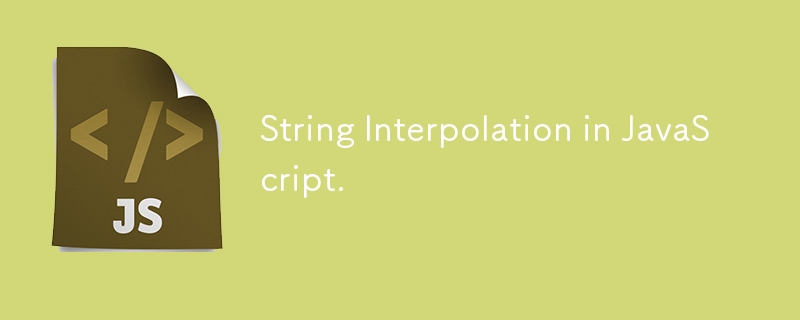JavaScript での文字列補間。

テンプレート リテラルの紹介。
文字列の操作は、プログラミング、特にインタラクティブな Web アプリケーションを構築する場合に非常に一般的なタスクです。 JavaScript の作業に時間を費やしたことがあれば、文字列に変数を入力する必要があったことがあるでしょう。
古いバージョンの JavaScript では、これは演算子を使用して、文字列連結 と呼ばれるプロセスを通じて文字列を結合することを意味していました。ただし、JavaScript ES6(2015) アップデートでは テンプレート リテラル が導入されました。 文字列補間.
テンプレートリテラルとは何ですか?
テンプレート リテラルを使用すると、文字列を簡単に操作できるようになります。これらは (') や (") ではなくバッククォート (`) で囲まれており、変数を配置する (${}) 構文を使用した文字列補間、または文字列に直接関数呼び出しをサポートします。
これは、テンプレート リテラルが文字列補間を簡略化する方法の例です。
const name = "John"
const age = 24
// Old method using concatenation
const greeting = "Hello, " name "! You are " age " years old."
// New method using template literals
const greetingWithTemplateLiteral = `Hello, ${name}! You are ${age} years old.`
console.log(greetingWithTemplateLiteral) // Outputs: Hello, John! You are 24 years old.
テンプレート リテラルを使用する利点
1. 読みやすさの向上
文字列の連結を使用する場合、特に長い文字列を扱う場合には、大量の記号に迷いやすくなります。テンプレート リテラルは、わかりやすい方法で文字列を記述できるようにすることでこれを回避します。
const product = "laptop"
const price = 1400
console.log(`The price of the ${product} is $${price}`)
// Outputs: The price of the laptop is $1400
2. 複数行の文字列
テンプレート リテラルが使用される前は、\n などのエスケープ文字を使用して複数行の文字列を作成する必要がありました。バッククォート(`).
の中に記述できるようになりました。
// Old method const multiLineString1 = "This is the first line" "\n" "This is the second line" "\n" "This is the third line" // New method const multiLineString2 = `This is the first line This is the second line This is the third line` console.log(multiLineString1) console.log(multiLineString2) /* Both output: This is the first line This is the second line This is the third line */
3. 式の評価
計算を実行したり、関数を呼び出したり、文字列内のデータを操作したりすることもできます。
const a = 1
const b = 10
console.log(`The sum of a and b is ${a b}`)
// Outputs: The sum of a and b is 11
const upperCaseName = (name) => name.toUpperCase()
console.log(`Your name in uppercase is ${upperCaseName("John")}`)
// Outputs: Your name in uppercase is JOHN
JavaScript の一般的な使用例
1. HTML 生成
連結して HTML 文字列を構築する代わりに、補間を使用して変数を文字列に直接挿入できます。
const name = "John" const htmlContent = `Hello, ${name}!
Welcome to the site.
`
2. メッセージのログ記録
連結せずに変数をログ メッセージに直接挿入することもできます。
const user = "John"
const action = "logged in"
console.log(`User ${user} just ${action}`)
// Outputs: User John just logged in
3. URLの作成
テンプレート リテラルを使用すると、URL の構築も簡単になります。
const userId = 123
const apiUrl = `https://api.example.com/user/${userId}/details`
console.log(apiUrl)
// Outputs: https://api.example.com/user/123/details
4. 条件付きロジック
もう 1 つの優れた使用例は、条件付きロジックです。テンプレート リテラルを使用すると、if-else 条件の短縮形である三項演算子 (? :) を使用して文字列に単純な条件を与えることができます。
&& (and) や || などの論理演算子(or) は、文字列に条件部分を追加するためにも使用できます。これにより、余分な if-else ステートメントや連結の必要がなくなります。
const isMember = true
console.log(`User is ${isMember ? 'a member' : 'not a member'}`)
// Outputs: User is a member
テンプレート リテラル内にさらに複雑な式を追加することもできます。
/* In this example, the condition age >= 18 is evaluated
the result is either “an adult” or “a minor” based on the value of age*/
const age = 24
const message = `You are ${age >= 18 ? 'an adult' : 'a minor'}`
console.log(message)
// Outputs: You are an adult
/*In this, if isLoggedIn is true and username exists
username is displayed or else, it defaults to “Guest” */
const isLoggedIn = true
const username = "John"
const greeting = `Welcome ${isLoggedIn && username ? username : 'Guest'}`
console.log(greeting)
// Outputs: Welcome John
結論
JavaScript のテンプレート リテラルは、文字列補間を処理するためのよりクリーンで効率的な方法を提供します。この方法は、Web コンテンツの構築、メッセージのログ記録、または読みやすいコードの作成の間に、必要な柔軟性を提供します。
次回変数と文字列を操作するときは、テンプレート リテラルを使用してみてください。これが JavaScript を操作するための私にとっての頼りになる方法である理由がすぐにわかります。
リソース
- MDN Web ドキュメント - テンプレート リテラル
- GitHub - フェーズ 1 レビュー Strings Lab
- W3 Schools - JavaScript テンプレート文字列
-
 Pythonの文字列から絵文字を削除する方法:一般的なエラーを修正するための初心者のガイド?emojisをpython emojisの除去する絵文字を削除するための提供されたPythonコードは、構文誤差が含まれているため失敗します。 Unicode文字列は、Python 2のU ''プレフィックスを使用して指定する必要があります。さらに、Re.Unicod...プログラミング 2025-04-18に投稿されました
Pythonの文字列から絵文字を削除する方法:一般的なエラーを修正するための初心者のガイド?emojisをpython emojisの除去する絵文字を削除するための提供されたPythonコードは、構文誤差が含まれているため失敗します。 Unicode文字列は、Python 2のU ''プレフィックスを使用して指定する必要があります。さらに、Re.Unicod...プログラミング 2025-04-18に投稿されました -
 jQueryを使用して「:After」pseudo-elementのCSS属性を効果的に変更するにはどうすればよいですか?jQueryにおける擬似要素の制限を理解する: "after" after "selector in web開発のように、「擬似要素のような」:後の「擬似要素」:後の視覚的拡張を追加することができます。ただし、jQueryを使用してこれらの要素にアクセス...プログラミング 2025-04-18に投稿されました
jQueryを使用して「:After」pseudo-elementのCSS属性を効果的に変更するにはどうすればよいですか?jQueryにおける擬似要素の制限を理解する: "after" after "selector in web開発のように、「擬似要素のような」:後の「擬似要素」:後の視覚的拡張を追加することができます。ただし、jQueryを使用してこれらの要素にアクセス...プログラミング 2025-04-18に投稿されました -
 CSSフォント属性が定義されていないときに、JavaScriptで実際のレンダリングされたフォントを取得するにはどうすればよいですか?css javascript object.style.fontfamily and object.style.style.style.style.styles fort not not not not not not not not not not not not not not ...プログラミング 2025-04-18に投稿されました
CSSフォント属性が定義されていないときに、JavaScriptで実際のレンダリングされたフォントを取得するにはどうすればよいですか?css javascript object.style.fontfamily and object.style.style.style.style.styles fort not not not not not not not not not not not not not not ...プログラミング 2025-04-18に投稿されました -
 PHPのUnicode文字列からURLに優しいナメクジを効率的に生成するにはどうすればよいですか?効率的なナメクジ生成のための関数を作成する スラッグの作成、URLで使用されるユニコード文字列の単純化された表現は、挑戦的な作業になります。この記事では、スラッグを効率的に生成し、特殊文字と非ASCII文字をURLに優しい形式に変換するための簡潔なソリューションを紹介します。一連の操作を使...プログラミング 2025-04-18に投稿されました
PHPのUnicode文字列からURLに優しいナメクジを効率的に生成するにはどうすればよいですか?効率的なナメクジ生成のための関数を作成する スラッグの作成、URLで使用されるユニコード文字列の単純化された表現は、挑戦的な作業になります。この記事では、スラッグを効率的に生成し、特殊文字と非ASCII文字をURLに優しい形式に変換するための簡潔なソリューションを紹介します。一連の操作を使...プログラミング 2025-04-18に投稿されました -
 すべてのブラウザでテキストを左調整するスラッシュメソッドを実装する] ] text line background background を斜めのラインで左に並べたテキストを達成することは、課題を引き起こす可能性があります。互換性(IE9に戻る)。 .lop((@i -1)); .space@{i} { 幅:floor(@i*@hsize...プログラミング 2025-04-18に投稿されました
すべてのブラウザでテキストを左調整するスラッシュメソッドを実装する] ] text line background background を斜めのラインで左に並べたテキストを達成することは、課題を引き起こす可能性があります。互換性(IE9に戻る)。 .lop((@i -1)); .space@{i} { 幅:floor(@i*@hsize...プログラミング 2025-04-18に投稿されました -
 解決する方法\「スクリプト... \ "Androidのコンテンツセキュリティポリシーによるエラーのロードを拒否しましたか?ミステリーを発表する:コンテンツセキュリティポリシー指示エラー 謎めいたエラーに遭遇する「スクリプトのロードを拒否する...」Androidアプリを展開するときに?この問題は、信頼されていないソースからのリソースの負荷を制限するコンテンツセキュリティポリシー(CSP)指令に由来しています。...プログラミング 2025-04-18に投稿されました
解決する方法\「スクリプト... \ "Androidのコンテンツセキュリティポリシーによるエラーのロードを拒否しましたか?ミステリーを発表する:コンテンツセキュリティポリシー指示エラー 謎めいたエラーに遭遇する「スクリプトのロードを拒否する...」Androidアプリを展開するときに?この問題は、信頼されていないソースからのリソースの負荷を制限するコンテンツセキュリティポリシー(CSP)指令に由来しています。...プログラミング 2025-04-18に投稿されました -
 Javaのコレクショントラバーサルのために、for-for-eachループとイテレーターを使用することにパフォーマンスの違いはありますか?vs. Iterator:コレクショントラバーサルの効率この記事では、これら2つのアプローチの効率の違いを調査します。内部的にiteratorを使用します: list a = new ArrayList (); for(整数整数:a){ integer.toString(); } ...プログラミング 2025-04-18に投稿されました
Javaのコレクショントラバーサルのために、for-for-eachループとイテレーターを使用することにパフォーマンスの違いはありますか?vs. Iterator:コレクショントラバーサルの効率この記事では、これら2つのアプローチの効率の違いを調査します。内部的にiteratorを使用します: list a = new ArrayList (); for(整数整数:a){ integer.toString(); } ...プログラミング 2025-04-18に投稿されました -
 Java文字列に複数のサブストリングを効率的に交換するにはどうすればよいですか?java で複数のサブストリングを弦の複数のサブストリングを置き換えると、文字列内の複数のサブストリングを置き換える必要性に直面すると、弦楽列の方法を繰り返し担当するブルートのアプローチに頼ることに魅力的です。ただし、これは大きな文字列や多数の文字列を使用する場合は非効率的です。正規表...プログラミング 2025-04-18に投稿されました
Java文字列に複数のサブストリングを効率的に交換するにはどうすればよいですか?java で複数のサブストリングを弦の複数のサブストリングを置き換えると、文字列内の複数のサブストリングを置き換える必要性に直面すると、弦楽列の方法を繰り返し担当するブルートのアプローチに頼ることに魅力的です。ただし、これは大きな文字列や多数の文字列を使用する場合は非効率的です。正規表...プログラミング 2025-04-18に投稿されました -
 Pythonの理解を使用して辞書を効率的に作成するにはどうすればよいですか?python辞書の理解 Pythonでは、辞書の概念は新しい辞書を生成するための簡潔な方法を提供します。それらはリストの概念に似ていますが、いくつかの顕著な違いがあります。キーと値を明示的に指定する必要があります。たとえば、 d = {n:n ** 2の範囲(5)} これは、0から4の...プログラミング 2025-04-18に投稿されました
Pythonの理解を使用して辞書を効率的に作成するにはどうすればよいですか?python辞書の理解 Pythonでは、辞書の概念は新しい辞書を生成するための簡潔な方法を提供します。それらはリストの概念に似ていますが、いくつかの顕著な違いがあります。キーと値を明示的に指定する必要があります。たとえば、 d = {n:n ** 2の範囲(5)} これは、0から4の...プログラミング 2025-04-18に投稿されました -
 PostgreSQLの各一意の識別子の最後の行を効率的に取得するにはどうすればよいですか?postgresql:各一意の識別子の最後の行 を抽出します。次のデータを検討してください: select distinct on (id) id, date, another_info from the_table order by id, date desc; データセット内の一...プログラミング 2025-04-18に投稿されました
PostgreSQLの各一意の識別子の最後の行を効率的に取得するにはどうすればよいですか?postgresql:各一意の識別子の最後の行 を抽出します。次のデータを検討してください: select distinct on (id) id, date, another_info from the_table order by id, date desc; データセット内の一...プログラミング 2025-04-18に投稿されました -
 ChatBotコマンドの実行のためにリアルタイムでstdoutをキャプチャしてストリーミングする方法は?コマンド実行からリアルタイムでstdoutをキャプチャする 再起動のライン(コマンド): print(line) このコードでは、subprocess.popen()関数を使用して指定されたコマンドを実行します。 stdoutパラメーターは、subprocess....プログラミング 2025-04-18に投稿されました
ChatBotコマンドの実行のためにリアルタイムでstdoutをキャプチャしてストリーミングする方法は?コマンド実行からリアルタイムでstdoutをキャプチャする 再起動のライン(コマンド): print(line) このコードでは、subprocess.popen()関数を使用して指定されたコマンドを実行します。 stdoutパラメーターは、subprocess....プログラミング 2025-04-18に投稿されました -
 なぜ `body {margin:0; } `常にCSSの上限を削除しますか?css の扱います。多くの場合、「ボディ{マージン:0;}」などの提供されたコードは、目的の結果を生成しません。これは、コンテンツの親要素が正のパディング値を持っている場合に発生する可能性があります。特定のマージンの問題に対処することをお勧めします。親要素にパディングがある場合、それを...プログラミング 2025-04-18に投稿されました
なぜ `body {margin:0; } `常にCSSの上限を削除しますか?css の扱います。多くの場合、「ボディ{マージン:0;}」などの提供されたコードは、目的の結果を生成しません。これは、コンテンツの親要素が正のパディング値を持っている場合に発生する可能性があります。特定のマージンの問題に対処することをお勧めします。親要素にパディングがある場合、それを...プログラミング 2025-04-18に投稿されました -
 マウスクリック時にDiv内のすべてのテキストをプログラム的に選択するにはどうすればよいですか?マウスクリックでプログラムをプログラム的に選択する 質問 テキストコンテンツのdiv要素が与えられた場合、ユーザーは1つのマウスクリックでdiv内のテキスト全体をプログラム的に選択できますか?これにより、ユーザーは選択したテキストを簡単にドラッグアンドドロップしたり、直接コピーしたりできます。...プログラミング 2025-04-18に投稿されました
マウスクリック時にDiv内のすべてのテキストをプログラム的に選択するにはどうすればよいですか?マウスクリックでプログラムをプログラム的に選択する 質問 テキストコンテンツのdiv要素が与えられた場合、ユーザーは1つのマウスクリックでdiv内のテキスト全体をプログラム的に選択できますか?これにより、ユーザーは選択したテキストを簡単にドラッグアンドドロップしたり、直接コピーしたりできます。...プログラミング 2025-04-18に投稿されました -
 「JSON」パッケージを使用してGOでJSONアレイを解析する方法は?json arrays in jsonパッケージ 問題: 次のGOコードを検討してください: タイプjsontype struct { 配列[]文字列 } func main(){ datajson:= `[" 1 "、" 2 "...プログラミング 2025-04-18に投稿されました
「JSON」パッケージを使用してGOでJSONアレイを解析する方法は?json arrays in jsonパッケージ 問題: 次のGOコードを検討してください: タイプjsontype struct { 配列[]文字列 } func main(){ datajson:= `[" 1 "、" 2 "...プログラミング 2025-04-18に投稿されました -
 formdata()で複数のファイルアップロードを処理するにはどうすればよいですか?formdata() を使用して複数のファイルアップロードを処理すると、複数のファイルアップロードを処理する必要があることがよくあります。 fd.append("fileToUpload[]", files[x]);メソッドはこの目的に使用でき、単一のリクエストで複数...プログラミング 2025-04-18に投稿されました
formdata()で複数のファイルアップロードを処理するにはどうすればよいですか?formdata() を使用して複数のファイルアップロードを処理すると、複数のファイルアップロードを処理する必要があることがよくあります。 fd.append("fileToUpload[]", files[x]);メソッドはこの目的に使用でき、単一のリクエストで複数...プログラミング 2025-04-18に投稿されました
中国語を勉強する
- 1 「歩く」は中国語で何と言いますか? 走路 中国語の発音、走路 中国語学習
- 2 「飛行機に乗る」は中国語で何と言いますか? 坐飞机 中国語の発音、坐飞机 中国語学習
- 3 「電車に乗る」は中国語で何と言いますか? 坐火车 中国語の発音、坐火车 中国語学習
- 4 「バスに乗る」は中国語で何と言いますか? 坐车 中国語の発音、坐车 中国語学習
- 5 中国語でドライブは何と言うでしょう? 开车 中国語の発音、开车 中国語学習
- 6 水泳は中国語で何と言うでしょう? 游泳 中国語の発音、游泳 中国語学習
- 7 中国語で自転車に乗るってなんて言うの? 骑自行车 中国語の発音、骑自行车 中国語学習
- 8 中国語で挨拶はなんて言うの? 你好中国語の発音、你好中国語学習
- 9 中国語でありがとうってなんて言うの? 谢谢中国語の発音、谢谢中国語学習
- 10 How to say goodbye in Chinese? 再见Chinese pronunciation, 再见Chinese learning

























